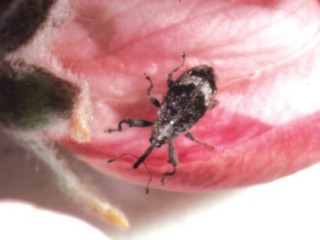
Apple blossom weevil was one of the most destructive apple pests before the advent of insecticides. In the past it was uncommon in conventional commercial apple orchards as it was controlled very effectively with organochlorine insecticides. The last of these, HCH (Gammacol, Lindane), was withdrawn from use several years ago and apple blossom weevil has since been increasing in importance.
Although it is still uncommon in conventional commercial apple orchards, it is one of the most important pests in organic apple orchards. Apple is the normal host, but pear, quince and medlar are sometimes attacked. Post-hibernating adults show preferences for certain varieties (e.g. James Grieve) in mixed apple orchards but the relative susceptibility of different varieties has not been quantified adequately.
The pest is widespread and common in unsprayed apple orchards but uncommon and locally distributed in commercial orchards sprayed with conventional insecticides. The weevil often occurs in greatest numbers round the margins of apple orchards adjacent to woodland and hedgerows, which provide overwintering sites for the pest. The pest is thus more common in orchards in areas which are wooded and where there are organic, unsprayed or derelict orchards in the vicinity.
Most stages are readily recognised.
- Brown capped blossoms, formed after the larvae have nipped the petal bases to arrest their development, are the characteristic damage of this pest.

- Capped blossoms mostly do not develop into fruits but on some varieties (e.g. Fiesta) some fruits develop to harvest. These are malformed and flattened in shape.
- In orchards where the pest has not hitherto been seen, watch out for capped blossoms on trees at the edges of the orchard. This is the first sign that the pest is increasing. This should prompt assessment and treatment if necessary in subsequent years.
- The life cycle involves the weevil overwintering as an adult mainly in woodland and hedgerows adjacent to orchards and emerges in early spring to fly into apple orchards at around bud burst. The adult is strongly attracted to bursting apple buds.
- Assess the populations of adult weevils in orchards at risk in early spring at bud burst using the beating method. If 5 or more weevils are collected in a 50 beat sample, significant damage is likely to occur and insecticide treatment is justified.
- Similar damage may be caused by some other pests.
Control
There are some natural enemies of this pest but generally it is controlled by application of a spray of a broad-spectrum insecticide against adults at or shortly after bud burst, after the migration into the orchard has finished but before significant numbers of eggs are laid.
- This is usually at or before the mouse ear growth stage.
- Most insecticides currently available have little effect on eggs or larvae in blossoms though sprays of insecticides in June and July may control newly emerged adults before they migrate to their overwintering quarters.
- Fatty acids (Flipper) is one of the few insecticides approved for use on apple (EAMU) with a recommendation for controlling apple blossom weevil.
- It is likely that indoxacarb (Steward or Explicit), when used to control tortrix, codling or winter moth caterpillars, will provide incidental control of apple blossom weevil, although their efficacy has not been explored.
- Synthetic pyrethroid insecticides are also highly effective but their use should be avoided as they are harmful to the orchard predatory mite Typhlodromus pyri and other natural enemies.
| Choice of insecticides - efficacy factors | ||||
|---|---|---|---|---|
| Active ingredient | Trade name (examples) | Class | Recommended by the manufacturer for control of | Safety to Typhs |
| deltamethrin | Decis Forte etc. | pyrethroid | Aphids, suckers, capsids, caterpillars, codling and tortrix moths, sawflies | harmful |
| fatty acids | Flipper (EAMU 3419/19) | bioinsecticide | Aphids, blossom weevil, two-spotted spider mite | unspecified but generally safe in IPDM programmes |
| indoxacarb | Steward, Explicit | oxadiazine | Codling, tortrix and winter moth caterpillars | unspecified |
| Choice of insecticides – Safety factors | |||||||
|---|---|---|---|---|---|---|---|
| Hazards | Harvest interval (days) | Max. no. sprays | Buffer zone width (m) | ||||
| Anticholin-esterase? | Humans | Fish & aquatic life | Bees | ||||
| deltamethrin | no | h,i | ed | d | 7 | u | 50 |
| fatty acids | no | h,i | h | u | 0 | 8 | 20 |
| indoxacarb | no | h | ed | u | 7 | 3 | 5 |
| Keys: 1d=dangerous, ed=extremely dangerous, h=harmful, i=irritant, u=uncategorised, unclassified, unspecified | |||||||
Control in organic orchards
The apple blossom weevil is one of the most important pests in organic apple orchards. There are no effective chemical control methods which are permitted for use in organic apple production in the UK.
- In other European countries, early season sprays of pyrethrum or extract of the plant Quassia amara are used against adults.
- In the UK, pyrethrins (Pyrethrum 5 EC) was previously approved for use in organic orchards but permission had to be sought from certification bodies before use. However, approval for use of pyrethrins has been revoked on apple and stocks should have been used up by 31 May, 2020.
